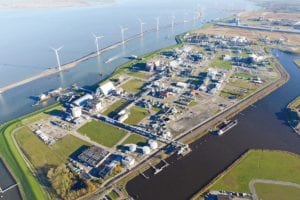This audio was created using Microsoft Azure Speech Services
Companies in various sectors are increasingly undertaking climate-rigorous efforts. Achieving these ambitious goals will require a variety of technological options and solutions, considering not only emissions, but also the reliability and cost of the technology. Natural gas is the cleanest fossil fuel according to the International Energy Agency (IEA). When we use it to generate electricity, we produce less greenhouse gas emissions than when we use coal or oil. About half as much as for coal, in fact.
Also, natural gas is well-suited to energy-intensive sectors that need a flexible fuel supply that can rise and fall according to demand.
Finally, natural gas power generation represents the best ‘peaker’ solution to cover up for peak electricity demand and/or renewable power intermittencies.
But with the influx of investments in renewable energy what is the future of natural gas as a fuel and what are the options for decarbonization?
If natural gas continues to be a part of our energy mix, we must decarbonize the way it is extracted, processed, and used. It is essential that we tackle the problem of natural gas associated emissions.
Improving energy efficiency is the easiest and most cost-effective method of decarbonization for natural gas industry.
Unintentional methane leaks most commonly occur at gas well sites or during processing and transportation. Since it is difficult to ensure the leak proofing of all gas connections, leaks may occur. Besides, when liquefied natural gas (LNG) is moved between storage systems gas emissions can occur.
Reducing these emissions is important because each leak reduces the environmental benefits of burning natural gas rather than coal or oil. And the fact that methane is a more potent greenhouse gas than carbon dioxide adds to the problem.
Technologies like digital twins help in evaluating the performance of certain assets in real-time to assist in analyzing the possibility of leaks. There are AI assisted leak detection solutions available today which can help in locating leaks faster. These help operators to ensure leaks are stopped much earlier. Leaks in transmission pipelines due to accidents are fully preventable with combined leak detection and intrusion detection solutions.
Having said that, there is still work to be done. Greenfield projects can use integrated power and process solutions for savings across complete lifecycle of the asset. Liquefaction plants can use electric driven technologies to replace traditional combustion technology. This allows operators to create greener LNG using lower carbon or renewable electricity. Process electrification will remain an important vector to achieve decarbonization in oil & gas industry.
In addition, we may capture CO2 created during the liquefaction process and bury it deep underground. The use of carbon capture and storage technologies is helping to clean up the manufacturing process. This process involves separating or extracting CO2 and transporting it underground where it is pumped into a deep reservoir through a pipe. Instead of releasing carbon dioxide into the atmosphere this method keeps it underground.
For decarbonized energy mix, Blue hydrogen is created by combining steam methane reform with carbon capture and sequestration (CCS) technology. In its current state blue hydrogen collects anywhere from 50% to 90% of the CO2 produced during the reforming process.
As companies work to decarbonize, hydrogen production will inevitably shift from gray to blue and green. Many of these discussions increasingly focus on hydrogen which provides a low-carbon alternative to hard-to-abate sectors of the economy such as certain industrial processes and transportation. Industry is developing its ability to repurpose existing infrastructure such as natural gas pipeline networks, salt cavern storage and gas turbine power plants. We can combine this with the potential to pair low or no carbon hydrogen production technology with zero emitting generating resources such as solar wind nuclear and hydro energy. All of this makes hydrogen an appealing solution in the gas and electric sectors. Where and when hydrogen could be an economically viable solution in the coming years is one of the important questions to be solved.
Blue hydrogen is a favorable near-term option for low-carbon hydrogen production.
Schneider Electric is leading the digital transformation of energy management and automation. Using IoT-enabled solutions to seamlessly connect, collect, analyze, and act on data in real-time which can deliver enhanced safety, efficiency, reliability, and sustainability performance of major industries, including Energies & Chemicals industries.
Interested in learning more?
Check out our latest whitepaper: How technology can help advance green hydrogen initiatives
Visit us online



